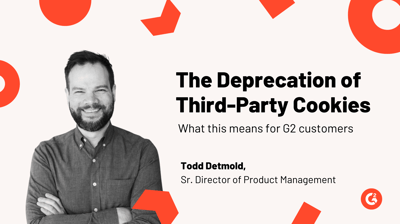May 28, 2022
 by Alyssa Quander Riley / May 28, 2022
by Alyssa Quander Riley / May 28, 2022

For years, marketers have relied on cookies, or little data files that contain personal identifiers, for user targeting and marketing measurement.
Increasing consumer demand for privacy and data protection is rendering many traditional digital marketing strategies useless. Luckily, you have some extra time to adapt your strategic mix for cookieless marketing since Google pushed its third-party (3P) cookie phaseout to mid-2023.
However, if you don’t act soon, you’ll face a measurement blackout or the inability to gauge the effectiveness of your campaigns, which makes it nearly impossible to prove marketing’s contribution to revenue.
But take heart. Once you've learned how to market effectively in a cookieless world, you'll discover that many of the alternatives you have available are just as effective as the third-party cookie-based approaches you used to rely on.
So let’s talk about getting your mix right for the cookieless future. But first, let’s do a quick 3P cookie review.
Third-party cookies are set by a third party AdTech and publisher platforms, for example, via code placed on the web domain by the domain owner. Any website that loads the third-party server’s code can access the cookies’ data, including users’ browsing history and personal data like age, location, gender, and more.
Marketers and advertisers use this information to deliver ads relevant to the user. An example is a timely Facebook ad for a product you’ve been researching during browsing sessions.
Going “cookieless” refers to a marketing approach that is less reliant on third-party cookies and uses other more transparent, privacy-centric tactics to target customers instead.
Whenever you visit a website, it will store at least one first-party cookie on your browser to remember your basic activity. That isn’t going to change unless you explicitly reject all cookies during your first visit.
Third-party cookies follow you around the web for retargeting purposes, helping brands lure you back to their sites to make a purchase. For example, if you visit a travel site that has ads from multiple hotels and attractions, each could create its own third-party cookies. The platforms behind these ads can track your activities across the web and ensure their ads appear on other sites you visit.
While retargeting ads like a well-timed, hyper-relevant Facebook ad can be unnerving, you might like the personalization and that extra reminder to make a purchase. But once cookieless digital marketing becomes the norm, you won’t have the timely, customized user experience you’re accustomed to. Instead, your experience will depend entirely on how the site owner has adapted to a cookieless world.
There are some concerning statistics and assumptions about what’s in store for publishers who have relied on 3P cookies. For instance, Google ran an experiment projecting the average publisher’s revenue would plummet by 52%.
That doesn’t necessarily spell trouble for everyone; it presents an opportunity to explore tactics that don’t rely on third-party cookies.
Those who succeed in a post-cookie world will prioritize first-party data collection and stewardship while promoting consent-based marketing transparency.
In other words, marketers will return to basics as the message and creative take center stage once again. They’ll learn about their audience through the information they collect themselves and optimize channels with the broadest appeal.
It’s understandable if you’ve relied on third-party data to explain consumer behavior across the different channels and elements that make up your marketing strategy – 83% of marketers still do.
But if you don’t embrace cookieless marketing, you’ll be in the dark when third-party cookies are disabled. You won’t know what your prospective customers want or what they’ll respond to, and you’ll be stuck serving up the same content to everyone, no matter where they are in the customer journey.
This predicament is known as measurement blackout or the inability to quantify the impact of your marketing efforts. Marketing measurement is crucial for marketing ROI and determining which campaigns are worth reinvesting in.

Every Thursday, we spill hot takes, insider knowledge, and news recaps straight to your inbox. Subscribe here
Unfortunately, adopting cookieless marketing isn’t as simple as flipping a switch. Instead, it demands creative innovation, new technology, and maybe a whole new organizational approach to data management. In addition, it is key to understand the difference in approaches for marketing vs. advertising.
Once cookies are deprecated, the granular measurements you’re used to will shift to broader tactics to support holistic, multichannel measurement strategies that respect consumer privacy.
Companies like Google, Amazon, and Facebook operate within highly monetized “walled” gardens. So, naturally, the more you leverage these platforms, the less you understand your customers and their journey.
While it’s important to advertise in these spaces, they aren’t the only game in town. A balanced and healthy marketing mix that provides more transparency is the better approach.
You’re going to be collecting more first-party data to compensate for the loss of third-party cookies. Therefore, data standards and metadata management are vital for maximizing its value and gaining insight into your customers’ journey.
Source: Claravine
A common set of data standards will ensure everyone speaks one data language and uses a shared approach to storing, sharing, and interpreting data. In addition, metadata management will organize your growing data stores, making information discoverable for analytics-based decisions and marketing measurement.
The cookieless future isn’t all bad for advertisers and publishers — so long as they evolve and leverage other data types and cookieless tactics.
For instance, they can use weather, context, and location to deliver relevant ads to consumers, or they can apply predictive analytics to determine how likely a consumer is to take action. And with artificial intelligence constantly improving, AdTech platforms can fill in the gaps once filled by cookies.
Cookieless digital marketing doesn’t mean you have to fly blind or revert to Mad Men-era tactics, but it does involve a broader, less granular approach to marketing. Thankfully, you have plenty of viable options to display relevant ads.
First-party data is firsthand information about your prospects and customers, such as email addresses, purchase history, demographics, and more. It’s highly accurate because you collect it yourself.
First-party cookies are automatically stored on users’ devices by the websites they visit. While recognizing returning users and their preferences is their primary function, they also help site owners perform analytics and build digital advertising campaigns.
The importance of first-party data in a post-cookie world cannot be overstated – your success depends on it. If you leverage it effectively, you can correlate touchpoints with confidence and generate a 360-degree view of your target audience.
However, you can’t just store or access information on users’ devices without consent. You’ll need to display a cookie banner (also known as a cookie notice) on the user’s first visit, set up a cookie policy, and give the option to opt-in.
Make it clear that accepting certain cookies allows you to retain information like login credentials, settings, and favorites and provide a more seamless checkout experience.
While zero-party data is arguably the most valuable of all data types, it’s also the hardest to obtain. There are many ways to collect it, but it is entirely up to the user to provide it.
Whether you ask questions during a registration process, ask for preferences for email marketing, or conduct social media polls, zero-party data helps you provide a more personalized experience to fuel long-term customer relationships.
Contextual advertising places ads based on the page content through keyword- and topic-based targeting instead of tracking the user. For example, if a user is on a page with a pumpkin pie recipe, you could show your ad for whipped cream dynamically.
This creates personalization without infringing on privacy and ensures brand safety by giving you control over the content you’ll appear alongside.
Cohort marketing involves segmenting your audience into smaller groups (cohorts) with similar characteristics, experiences, and propensities. Cohort analysis improves your marketing performance by identifying what unites users who take similar actions and then designing your campaigns accordingly.
Data clean rooms are secure software platforms that allow parties to share and match user-level data without revealing raw data or personally identifiable information (PII). They enable advertisers and brands to analyze performance and run attribution for targeted, privacy-friendly advertising campaigns.
Browser APIs like Google’s proposed Topics API offer cookie-like insights by identifying topics of interest based on users’ browsing habits. Websites that opt-in to Google Topics can display personalized ads based on what Chrome identifies as a user’s top interests over three weeks.
For instance, if a user’s browsing activity during Week 1 was dominated by visits to sites that sell ski equipment, their topic might be “Outdoor Recreation.” Likewise, different topics such as “Live Music” and “Books & Literature” might be chosen for weeks 2 and 3, assuming that reflected their browsing habits.
While browser APIs enable you to leverage interest-based marketing, your success depends on willing users as they’ll have control over their topics, including the ability to turn them off altogether.
Universal IDs (UID) are single identifiers that recognize a user across advertising platforms allowing publishers to display relevant ads without cookie synching. Some options have a third-party component and will need to adapt to using first-party data (i.e., CRM) and offline data once cookies are deprecated. There are several promising UIDs to consider depending on your needs, including Unified 2.0, ID5, Panorama ID, and more.
Marketing mix modeling (MMM) uses past performance data to provide insights into marketing techniques and allows you to understand trends such as holidays, seasonality, brand equity, and more. When granular details about the buyer’s journey aren’t available, MMM provides a broader picture and a way to answer simple questions, such as: What happens to sales if I increase my Facebook ad spend by a certain percentage?
Finding the optimal mix of cookieless marketing tactics to reach your audience isn’t going to be easy or quick. But to compete in a cookie-free world, you must get it right.
Those who excel at cookieless marketing will have something important in common: they’ll have processes, procedures, and tools firmly in place to unify and manage their data across their marketing ecosystem. In addition, by making data a strategic priority, they’ll be able to understand marketing effectiveness and ensure their Marketing operations tech stack is efficient, profitable, and cookieless-future proof.
Want to learn more about a strategy that doesn't involve third-party cookies? Check out our quick guide on contextual targeting.
Alyssa Quander Riley is the director of product marketing at Claravine. She brings over a decade of experience working at the intersection of customer, product, marketing, and sales and has a deep understanding of the challenges brands and agencies face in today’s changing digital landscape.
Since Google announced the elimination of third-party cookies and Apple announced changes that...
 by Hannah Stewart
by Hannah Stewart
Digital advertising run through ad networks and exchanges traditionally relied on third-party...
 by Sagar Joshi
by Sagar Joshi
For several years now, marketers and technology vendors alike have been preparing for the ...
 by Todd Detmold
by Todd Detmold
Since Google announced the elimination of third-party cookies and Apple announced changes that...
 by Hannah Stewart
by Hannah Stewart
Digital advertising run through ad networks and exchanges traditionally relied on third-party...
 by Sagar Joshi
by Sagar Joshi


